Art & Exhibitions
LACMA’s Islamic Art Curator on How Her Ambitious New Exhibition Reveals Another Side of Iran
Linda Komaroff talks about “In the Fields of Empty Days: The Intersection of Past and Present in Iranian Art.”
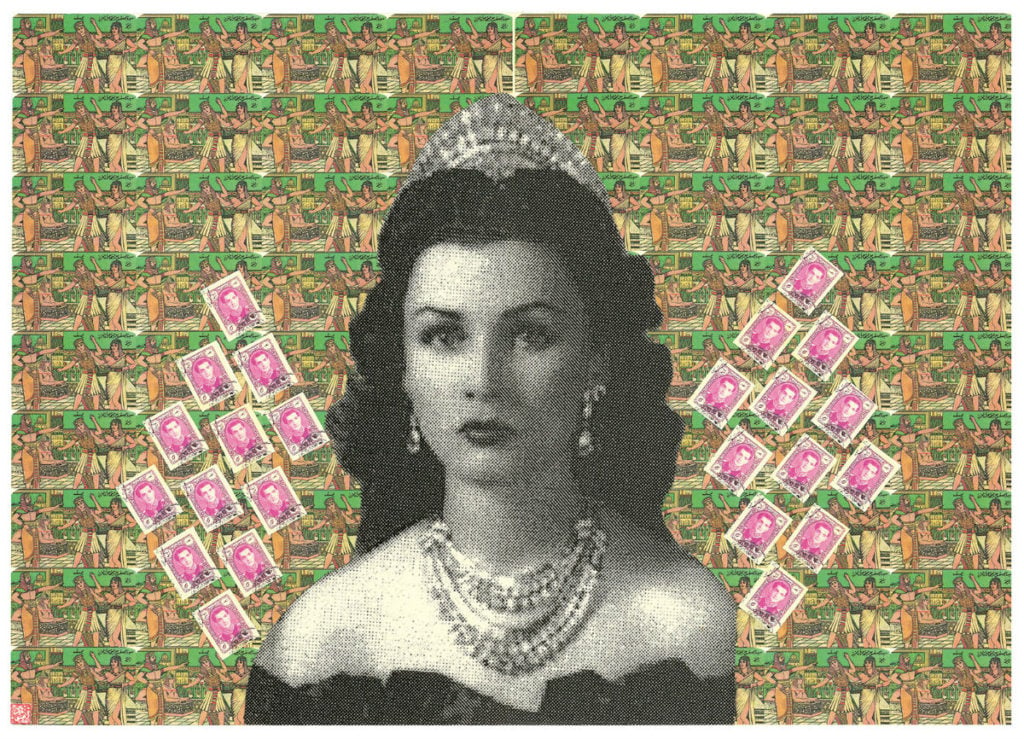
Linda Komaroff talks about “In the Fields of Empty Days: The Intersection of Past and Present in Iranian Art.”

Nilina Mason-Campbell

The new exhibit “In the Fields of Empty Days: The Intersection of Past and Present in Iranian Art” is the culmination of four years of work by LACMA’s Islamic art curator, Linda Komaroff. Assembling some 125 works of art, from photography to painting,and from posters to political cartoons, the striking show explores an intriguing and scholarly theme: the creative use of anachronism within Iranian art, showing both how tradition animates the present and how reference to the past can be a vehicle for subversive commentary today.
Komaroff has been at the LA museum since 1995, spearheading a wave of contemporary acquisitions for the Islamic art department. Recently, artnet News spoke with the curator about her vision for the exhibition, her relationship with the artists on display, Western bias towards Islamic art, and the peculiar relationship between Iranian art and time.
You have said that you were inspired to begin making acquisitions of contemporary Islamic art after attending the “Word into Art” exhibition at the British Museum in 2006 [a show dedicated to the tradition of calligraphic abstraction in the Middle East and North Africa]. What about it inspired you in particular?
One thing I was struck by were the audience reactions. They were so engaged with the art. There were a lot of works by Iraqi artists in the exhibition, at a time when British troops were still in Iraq. I just felt that, because the locations were suddenly more familiar from the media, people were having a different kind of reaction to the art. They were seeing a country that was just a blur of images as being composed of human beings who were capable of producing and appreciating beauty.
I was impressed by that; I had never seen that kind of reaction where people were talking to each other and were excited. I had never seen that in an historical Islamic art exhibition, and I thought that was something we should bring to our audience in Los Angeles. My colleagues in the contemporary art department were not particularly interested in the Middle East. And I was.
I discussed this with [LACMA director] Michael Govan, and he said, “sure, go ahead, do it.” He didn’t give me a budget to do it; I had to raise the money we needed to acquire works of art. I’m just guessing, but I think that now we probably have over 350 works in the collection.
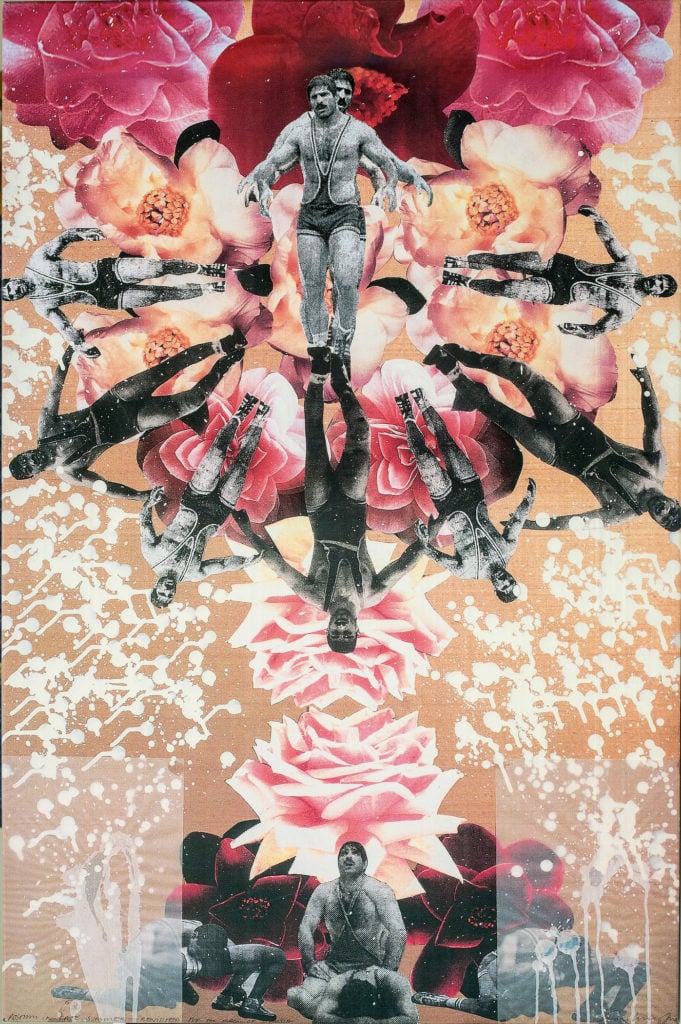
Fereydoun Ave, Untitled, from the series “Rostam in Late Summer—Revisited” (2009). Image courtesy Mohammed Afkhami Foundation © Fereydoun Ave, photo courtesy of Janet Rady Fine Art.
Generally, what is your ambition for the LACMA collection?
My ambition is to collect great art and add a complement to our historical collection, so that no visitors will ever make the mistake of thinking that this is a dead civilization. Most collections end at 1900 for Islamic art. I never questioned that in graduate school, only later. I want it to be seen as a living tradition.
With European painting and sculpture, a collection usually goes up to 1900, but then you have a modern and contemporary collection. Nobody assumes European art ended in 1900. They just see it in a different part of the museum. Art from the Middle East ends in 1900 too—but then it isn’t shown in any other part of the museum. My ambition is to show this tradition as something that’s continuing.
We mostly hear bad things about the Middle East and Islamic world. We want to be able to show the public how exciting contemporary art from this area is. Art offers a way of connecting on a human level, which we don’t get to do through media reports.
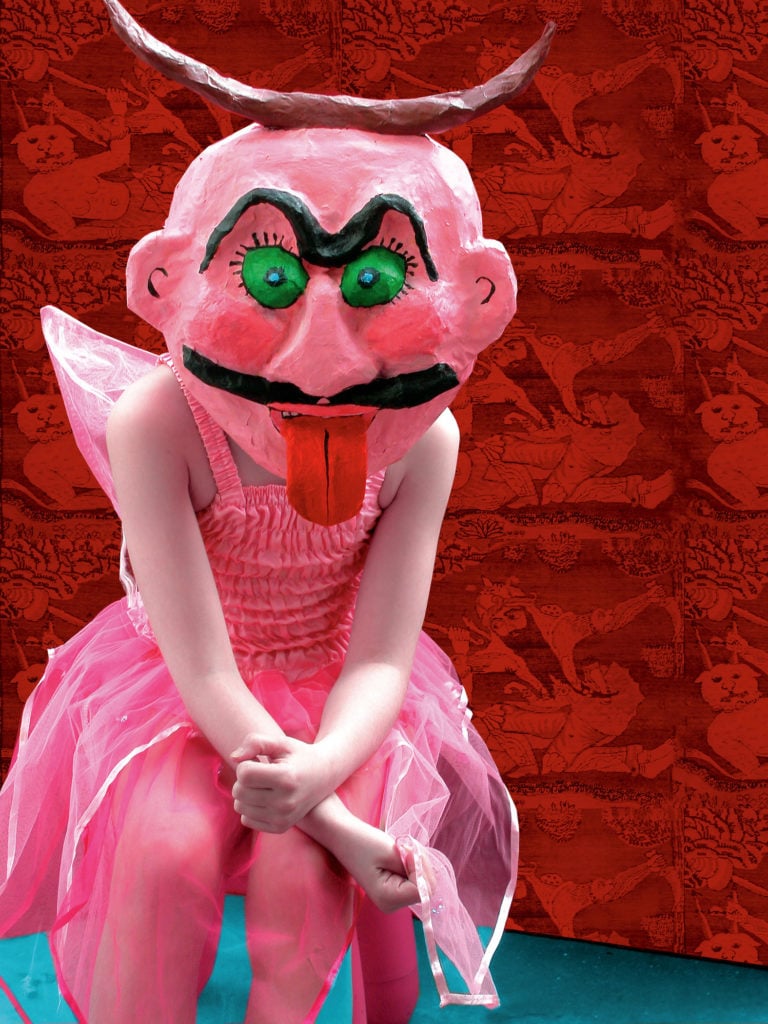
Malekeh Nayiny, All in Pink (2007). Image courtesy Los Angeles County Museum of Art, purchased with funds provided by Nina Ansary, © Malekeh Nayiny.
You brought up the example of how European art “ends” and then continues in the modern art section of museums. Why do you think contemporary Islamic art is overlooked in acquisitions and museums generally?
That’s something that has been changing in the last 15 years or so. In the past there was also relatively little interest in modern or contemporary art from China, for a lot of the same reasons. It’s in part Western bias, the idea that the interesting artistic movements of the time happened in the West.
One hopes we aren’t moving away from globalism, but moving towards becoming a more global society. Room has to be made at the table for more diverse types of people. It must be recognized that there is merit to other types of art from other places, as opposed to centering the discussion on Europe and America.
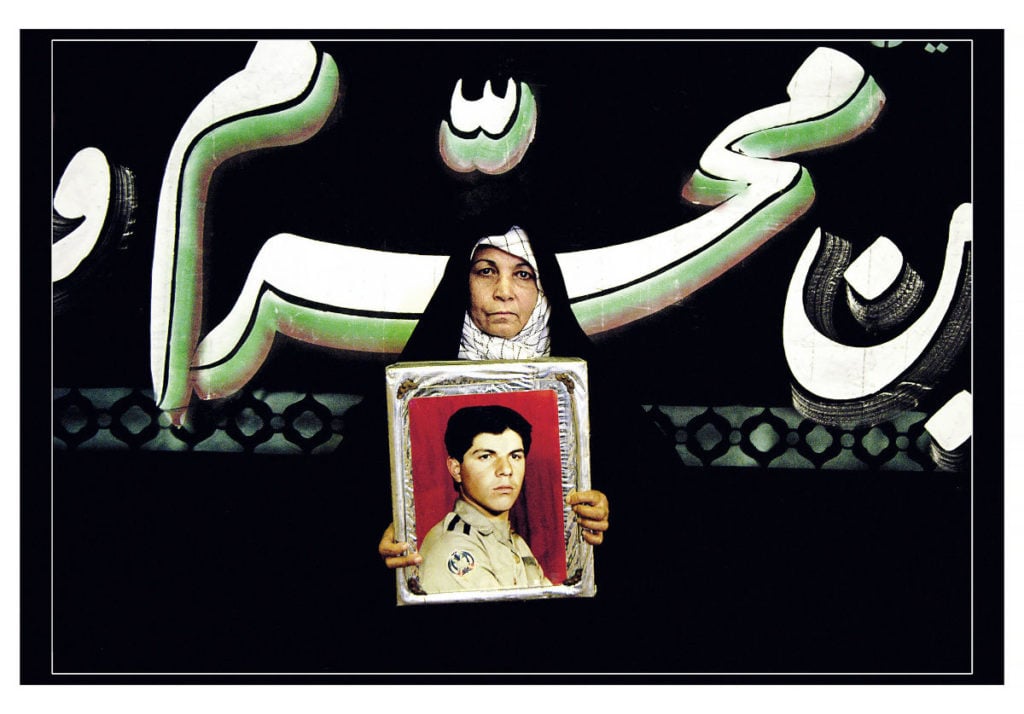
Newsha Tavakolian, Mothers of Martyrs (2006). Image courtesy Los Angeles County Museum of Art © Newsha Tavakolian, photo courtesy Thomas Erben Gallery.
The show is about how “ancient kings and heroes are used in later contexts” within Iranian art, among other things. Did the themes of this exhibition present themselves to you early on?
The exhibition is really about how time is dealt with in Iranian art. A little less than half of our contemporary Middle East collection is from Iran. Historically in art from Iran, time is presented in a very interesting manner.
Although they knew that Iran had a much longer past, when you get to the 14th, 15th, 16th, and 17th centuries, when Iranian artists depict the past of Iran—great kings and great heroes—they always show the past as though it were happening in the present. It was a way of flattering the contemporary ruler, to link the contemporary ruler to a great king or ruler from Iran’s past by, in the painting, dressing him the same way and having him drink from the same bowl and making the members of his court dress the way the ruler’s actual court is dressed. That’s fairly standard in Iranian art.
But when I started spending time looking at what contemporary artists in Iran and outside were doing, it was the opposite, starting from around the middle of the 20th century. Artists were no longer constrained by patrons as they had been in the past, working for royal patrons. They began producing art for themselves, and they wanted to express their own political and social ideas.
Since they couldn’t do this openly without offending the rulers—there was still a Shah in Iran and then later an Ayatollah—what they did was to take images from the past and put little hints and suggestions that they are really talking about the present. So it’s the opposite of what Iranian artists did in the past. They updated the past to the present.
Today, many Iranian artists are taking the present and hiding it in the past. One of the artists who dominates one of the first sections of the exhibition, Siamak Filizadeh, has a series of photographs that are digitally manipulated to look like they’re set in the 19th-century, but include elements that could only be in the present day.
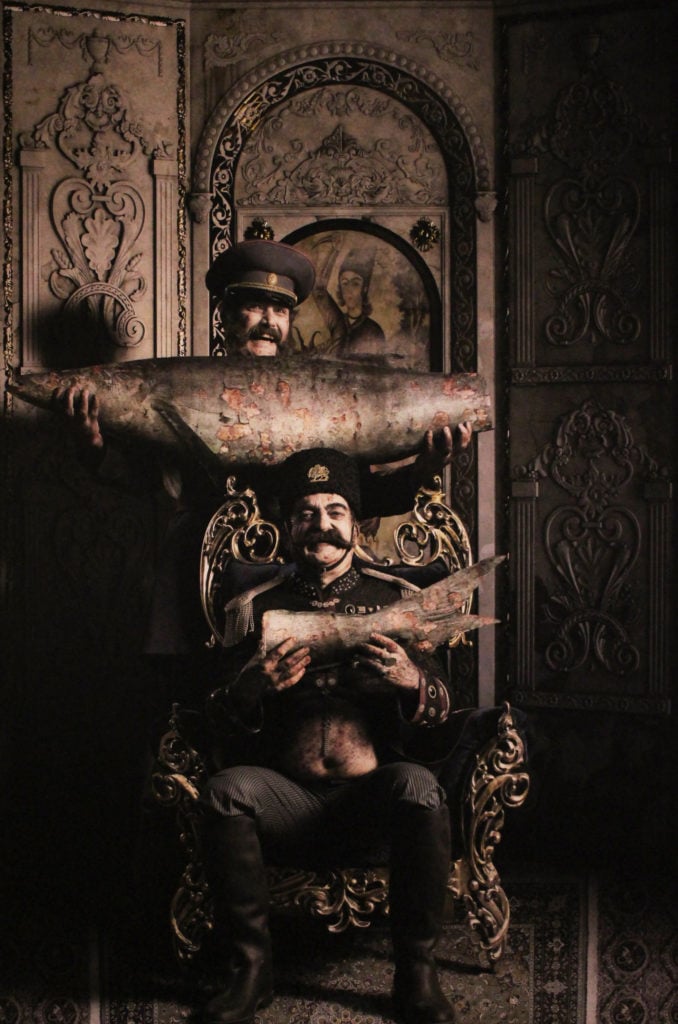
Siamak Filizadeh, Shah and the Russian Ambassador (2014). Image courtesy LACMA.
I was specifically thinking of the photograph with Russia and the fish [Siamak Filizadeh, Shah and the Russian Ambassador, 2014]. I was trying to think about it in terms of the past, but it also seems reflective of the current relationship of the countries.
It’s about Iran and the other powers in the world. If you know Iranian history you’ll know that in the 19th-century there was something called the “Great Game,” when Great Britain and Russia were trying to carve up Iran and actually did pull away pieces of it. That’s when some of the sections of Iran, Azerbaijan, and the Caucasus, moved over to the Russians. That part is true.
The fish is a sturgeon, and sturgeon of course come from the Caspian, which is the shared sea between Russia and Iran. It’s showing the Russians being piggier [by holding much more of the fish]. It suggests how foreign powers outside of Iran have always exploited it.
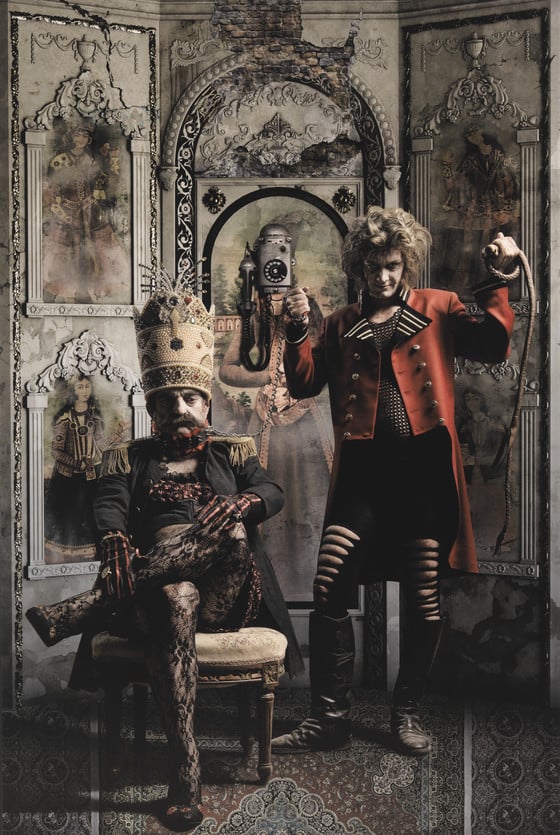
Siamak Filizadeh, Shah and the British Ambassador (2014). Image courtesy LACMA.
What I gathered from Filizadeh’s work with the British officer and the ruler in a chair [Siamak Filizadeh, Shah and the British Ambassador, 2014] was a sense of humiliation. Do you have a take on what that works means?
That is what is meant to say. The artist feminized the King and showed him in a humiliating posture.
I can tell you a story about that work: [Filizadeh] uses actors for the most part. This piece was shot very much as a movie would be, but obviously as a still image. The actor he got to play the King really didn’t want to put on the fishnet stockings and the corset. He kept saying, “why?”, and the artist kept saying, “you just need to trust me, it’s important.” But the actor was very reluctant to wear that particular costume.
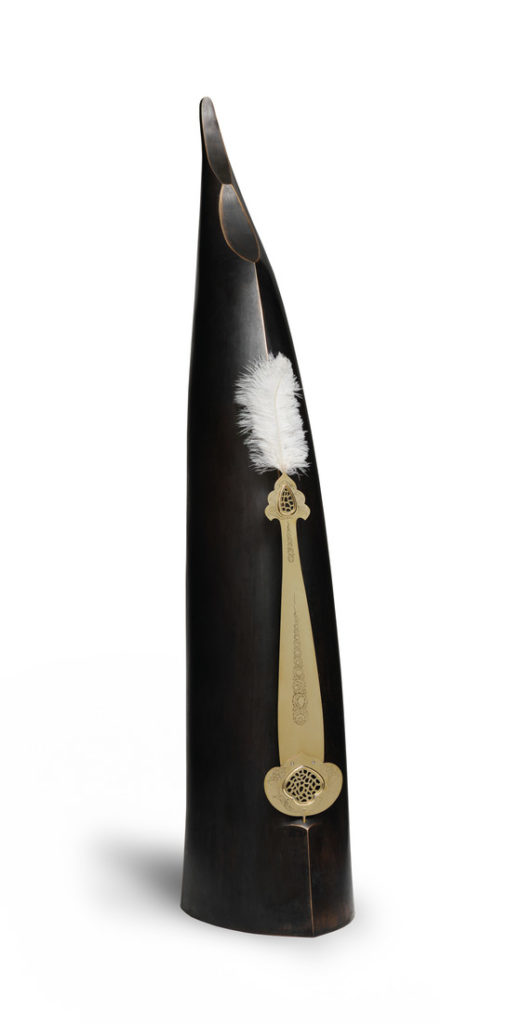
Kourosh Golnari, The Renowned Sovereign (2016). Image courtesy LACMA.
Yeah—I noticed his expression in the photo even more than the clothing. He’s averting his gaze from the camera. That’s interesting; it was the actor’s own feeling.
As I was walking around the exhibit, I noticed a few of the identification labels denoted if the artist is still active. Many of the artists noted as active were outside of Iran.
Not a lot of them are still in Iran, though the artist of those particular photographs [Filizadeh] is still in Iran.
The giant hat with a feather in it in one of the rooms [Kourosh Golnari, The Renowned Sovereign, 2017]—that artist is still in Iran. The tile panel [Khosrow Hassanzadeh, Remember, 2010]—that artist still lives in Iran.
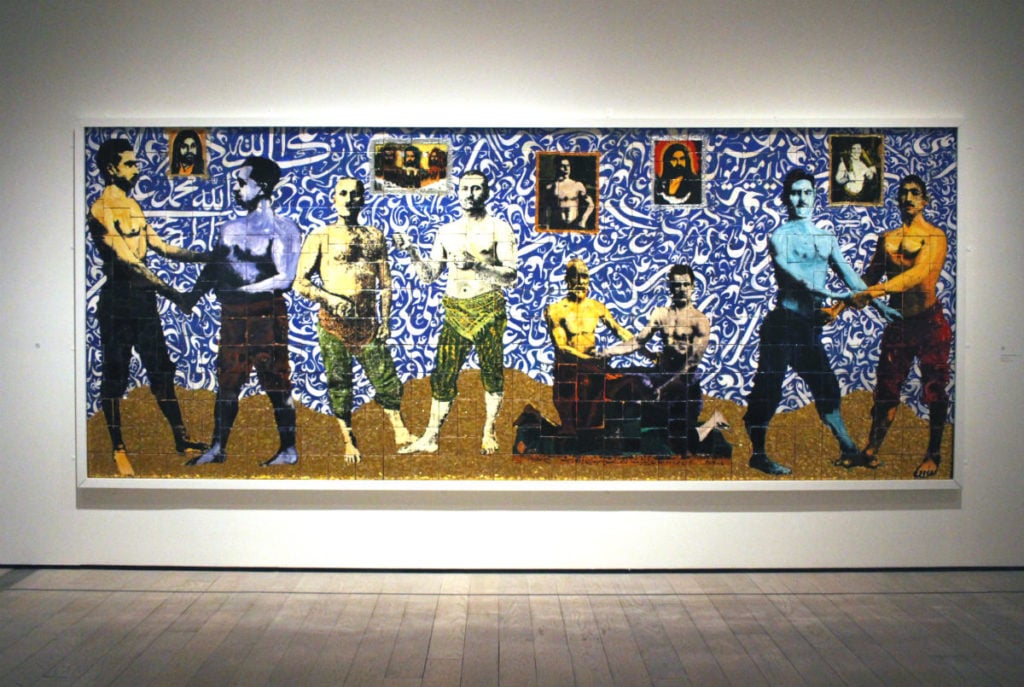
Khosrow Hassanzadeh, Remember (2010). Image courtesy Nilina Mason-Campbell.
Did you speak with any of the artists about what it’s like working in Iran? A lot of this art is rather provocative. Maybe not always to the extent of the first section with Filizadeh’s digitally manipulated imagery—but I had this question throughout. Can you say what it’s like for contemporary artists to be producing work there?
I do know most of the artists. I’ve met most of them whether they’re living in Iran or outside of Iran. They’re like artists anyplace else. There is certainly censorship in Iran, but more directed at the film industry than visual art. Sometimes exhibitions and galleries are closed down, but most of them are not.
I don’t want anyone to start scrutinizing their art more closely—but I think that a lot of it is ambiguous deliberately. It’s open to interpretation. I think art is often deliberately ambiguous for a variety of reasons, and they just have one more reason to be.
And for artists too who are living outside Iran but want to be able to continue to go back, they also perhaps have a bit more ambiguity in their work. Though if you take an artist like Shirin Neshat or her partner Shoja Azari, both of whom are well-represented in the exhibition, they’re based in America and they’re not going back to Iran. I think they have very strong views about the political situation in Iran and express it sometimes in their art and sometimes in their public statements as well.

Siamak Filizadeh, Return from Europe from the series “Underground” (2014). Image courtesy Los Angeles County Museum of Art © Siamak Filizadeh, digital image © Museum Associates/LACMA.
When it comes to meeting most of the artists that were featured, what was that process like? Were you meeting with them after you had acquired the works, or during the acquisitions? How are you crossing paths with these artists?
Usually as part of the acquisition process. I haven’t done it in the past year or so, but I go to Iran maybe once or twice a year and visit galleries in Tehran. If the gallerist knows you’re coming they might invite an artist to be there. Or if you’re interested in a particular artist they represent, they may call that artist up and invite them over.
With that group of [Filizadeh’s] photographs in the first gallery, with a 19th-century setting, we had already bought some work by that artist, so I knew him. His dealer was showing me his newest work, which we did acquire. I liked them, but I couldn’t make up my mind because she said, “you have to see them in person.”
Tehran is a lot like Los Angeles in terms of traffic, and the gallery was in the equivalent of downtown while the artist’s studio was in the equivalent of uptown. I couldn’t make up my mind if I wanted to deal with all the traffic. But I was really glad I braved the traffic to see the work in person.
The artist showed me all of his sketchbooks, because he did designs for all the costumes in the photos, made them look authentic, and had some of the props which he showed me. Photos of him wearing the crown that the Shah is wearing were in some of the photos. I was utterly enchanted by the art.
The artist that produced the tile panel [Khosrow Hassanzadeh, Remember, 2010], I’ve only been to his studio once, but I just liked talking to him. And I liked his work before I met him.
I think it’s always better to like the artist’s work before you meet them. Every now and then you haven’t seen their work and you like the artist, but then maybe aren’t that crazy about their work, and it’s a conflict. It’s always good to appreciate the work first; then you like the artist or you don’t, but still appreciate the work.
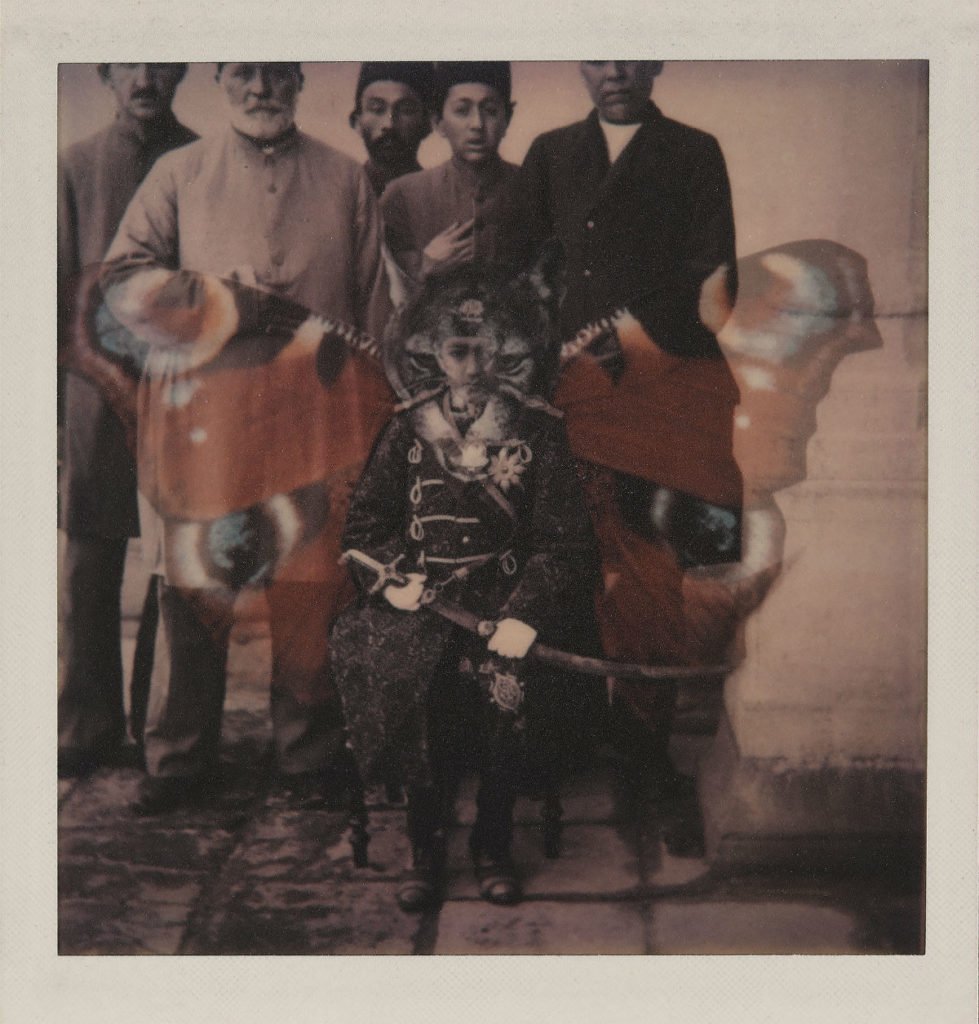
Kaveh Golestan, Untitled from the series “Az Div o Dad” (1976). Image courtesy Los Angeles County Museum of Art © Estate of Kaveh Golestan, digital image © Museum Associates/LACMA.
You started making acquisitions of contemporary Islamic art in 2006. How long were you working on this specific exhibition, and how soon did it come together after you began those acquisitions?
I only started working on it in 2014—so we had already been acquiring works of art for quite a while.
Once I had this idea for an exhibition that would be about the intersection of past and present, I wanted to incorporate some historical art but mostly focus on contemporary. So I directed my acquisitions to fill in gaps in our collection that could be included in our exhibition.
When did the final pieces for the show come together?
Just two weeks ago.

Parviz Tanavoli, Lion and Sword III, 1976, Bijar weave, 62 1/4 × 91 in., Los Angeles County Museum of Art, gift of Hope Warschaw through the 2018 Collectors Committee, courtesy of the artist, © Parviz Tanavoli, photo © Museum Associates/LACMA.
There are two carpets in the exhibition showing a lion, we were going to borrow them from the artist [Parviz Tanavoli]. But then I knew as soon as we took them out of the crate we had to have at least one—and a pair would be much better.
We have an annual acquisitions event here, which we had two weeks ago, called Collectors Committee. That was what I presented, and it was bought.
“In the Fields of Empty Days: The Intersection of Past and Present in Iranian Art” is on view at the Los Angeles County Museum of Art until September 9, 2018.